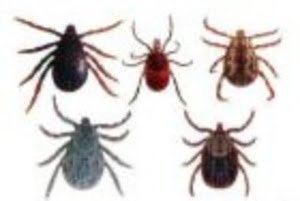Of the hundreds of species of ticks in the world, there are just two categories of ticks that transmit diseases to humans: hard ticks and soft ticks. Of the hard ticks, the most common are wood ticks, deer ticks, lone star ticks, and the American dog tick. The two soft ticks found in the United States are the Pajaroella tick and the spinose ear tick.
Ticks are crawling insects or bugs that hatch from larvae in the spring. They are found wherever potential hosts are found. When not feeding on a host, they hide in grass or brush, generally in wooded areas, until a potential host comes by. People, pets, rabbits, and deer make excellent hosts for ticks. When a potential host comes near enough to brush up against a tick, it will grab onto the host and crawl to an area to attach and feed.
Hard ticks feed for as little as a few hours to as long as a few days; soft ticks feed for less than an hour. Both kinds of ticks may transmit disease through their saliva as they’re feeding on their host’s blood, which they must have in order to live. If it doesn’t find a host, it will starve to death.
Ticks carry several different diseases. The most common are Lyme disease, Rocky Mountain Spotted Fever, Tularemia, Texas Fever, and Colorado Tick Fever. In addition to disease, ticks can also cause tick paralysis and, in extreme cases, death.
Most tick bites won’t result in disease or even a symptom that a tick has attached itself to you unless you feel it crawling on you or come across it after it’s attached. In those instances, there is nothing to be concerned about, except the nuisance or “ick” factor involved. However, in the event you do encounter a disease-bearing tick that bites or attaches itself, the bite or attachment site may become red, swollen and itchy. If you develop disease symptoms, they likely will not become apparent until days or weeks later, making diagnosis difficult unless you relate the tick experience to your symptoms. The usual symptoms of a tick-related disease are: flu-like symptoms (chills, nausea, vomiting), fever, painful and swollen joints, weakness, or breathing difficulties.
If you suspect you’ve been bitten by a disease-bearing tick, contact your doctor for direction and possible treatment.
If you are truly fearful of falling prey to a hungry tick, the best prevention is to stay away from outdoor areas where ticks flourish, from May through September. If this isn’t feasible or desirable, the next best thing is to minimize your availability as a host. Use a repellent specifically labeled to include ticks, keep your pets treated for fleas and ticks, and check yourself over when you return from an outing where ticks will likely be lying in wait. If you find a tick that has already attached itself, remove it carefully with a tweezers. Clean the area thoroughly and seek medical attention if the attachment site becomes inflamed or infected. If you find a tick crawling on you, remove it carefully and either flush it down the toilet or wash it down the drain. Don’t attempt to crush it in the event it happens to be of the disease-bearing kind.
Reference:
- Lyme Disease Foundation


